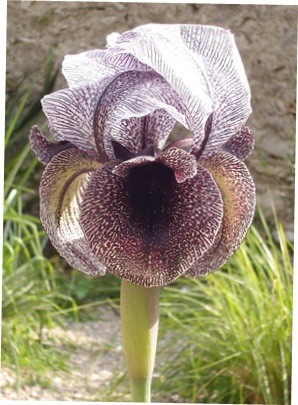Iris kirkwoodii
(Iris kirkwoodiae)

Description
Iris kirkwoodiae (or Iris kirkwoodii) is a plant species in the genus Iris, it is also in the subgenus Iris and in the section Oncocyclus. It is a rhizomatous perennial, from Syria and Turkey. It has white or pale greenish flowers, heavily covered with dark purple veins or dots, deep purple round signal and a beard of long brown/purple hairs. It is cultivated as an ornamental plant in temperate regions. The forms of Iris kirkwoodiae are between Iris gatesii and the also dark-veined Iris sofarana. It is also very similar in form to Iris susiana. It has a stout and compact rhizome,which is stoloniferous and between 1–2 cm (0.39–0.79 in) long, underneath the rhizome are long secondary roots, which help feed the plant mineral salts from the soil. It has 6-7 leaves, which grow up 30 cm (12 in) tall and between 0.5–2 cm (0.20–0.79 in) wide,They are falcate, or sickle shaped. It is tall, growing up to between 30–75 cm (12–30 in) tall. It blooms between April and May, with large, sphere-like flowers. It was determined that the plants found in Maras, Turkey seem to have the largest flowered forms. It has a faint pleasant scent. The flowers are between 13–18 cm (5.1–7.1 in) in diameter, and come in shades of beige, white or pale greenish ground, which is covered with violet, or dark purple veins and spots. Like other irises, it has 2 pairs of petals, 3 large sepals (outer petals), known as the 'falls' and 3 inner, smaller petals (or tepals), known as the 'standards'.: 17 The standards are generally paler than the falls. The standards are 7–10.5 cm (2.8–4.1 in) long and are 6–8 cm (2.4–3.1 in) wide. The deflexed falls, have a deep purple round or obovate signal patch, and in the centre of the fall, is a sparse, purple or brownish-purple beard. Occasionally forms have a red-brown or yellow beard. It has style arms which have erect or reflexed lobes. After it has flowered, it produces a seed capsule that is about 9 cm (3.5 in) long. As most irises are diploid, having two sets of chromosomes, this can be used to identify hybrids and classification of groupings.: 18 It was counted as 2n=20, by Avishai and Zohary in 1977.
Taxonomic tree:







